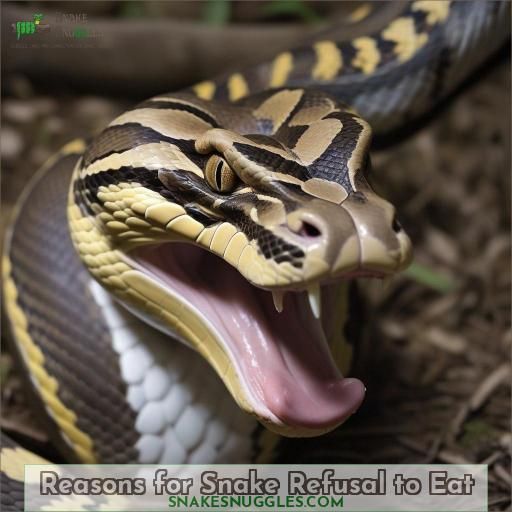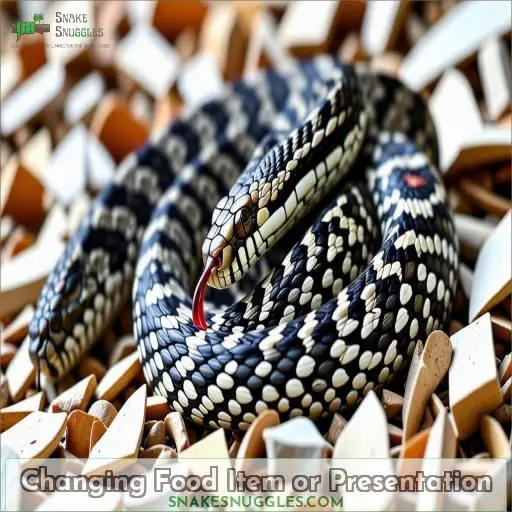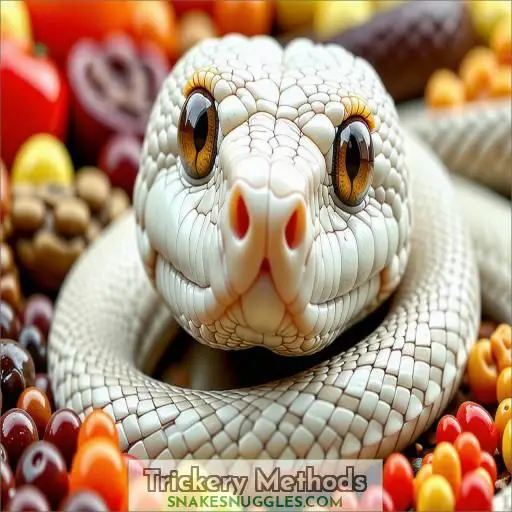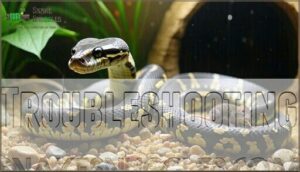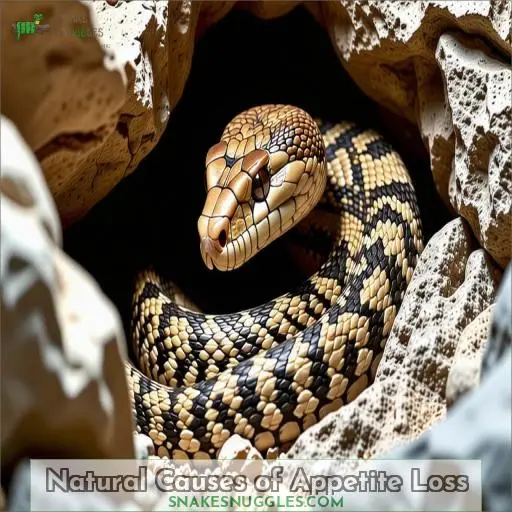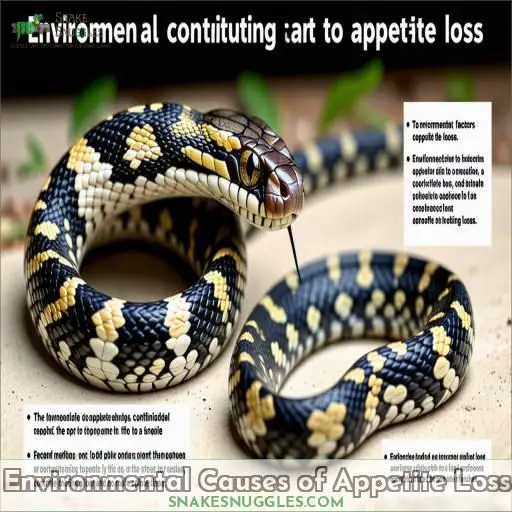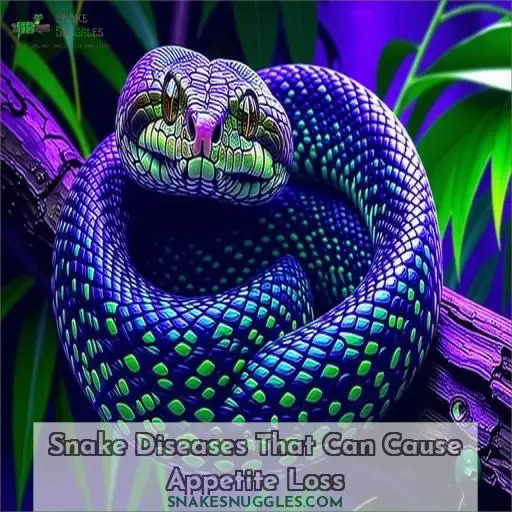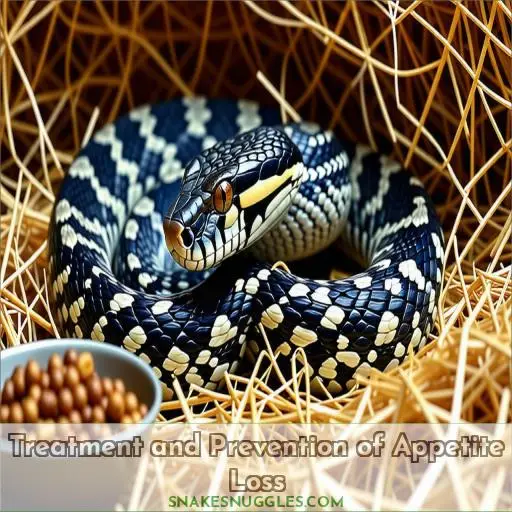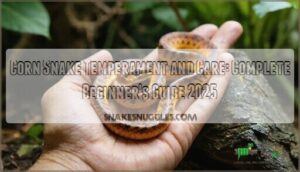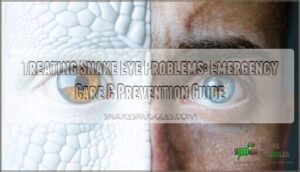This site is supported by our readers. We may earn a commission, at no cost to you, if you purchase through links.
 If your snake isn’t eating, don’t panic yet. There could be several reasons why it’s not hungry, including shedding, seasonal changes, or an improper environment. First, make sure the enclosure temp and humidity levels are ideal.
If your snake isn’t eating, don’t panic yet. There could be several reasons why it’s not hungry, including shedding, seasonal changes, or an improper environment. First, make sure the enclosure temp and humidity levels are ideal.
Next, examine your feeding habits – are you offering the right prey size and type? Sometimes snakes need a little trickery, like scented or warmed prey.
If you’ve ruled out husbandry issues, your snake might have an underlying health problem.
. Mouth rot, parasites, and respiratory infections can kill its appetite.
Stay patient, but consider taking your scaly pal for a vet visit to uncover the root cause and get that forked tongue flicking again.
Table Of Contents
- Key Takeaways
- Why is My Snake Not Eating?
- Reasons for Snake Refusal to Eat
- Changing Food Item or Presentation
- Trickery Methods
- Troubleshooting
- Natural Causes of Appetite Loss
- Environmental Causes of Appetite Loss
- Snake Diseases That Can Cause Appetite Loss
- Treatment and Prevention of Appetite Loss
- Frequently Asked Questions (FAQs)
- How long can a snake go without eating?
- How can I encourage my snake to eat?
- Is it normal for a snake to not eat for a month?
- Why isn’t my snake eating the mouse?
- How do I know if my snake is overweight?
- What are the signs of dehydration in snakes?
- How often should I handle my snake?
- Can I feed my snake live prey?
- What are the best substrate options for snakes?
- Conclusion
Key Takeaways
- Ensure ideal enclosure temperature and humidity levels
- Evaluate feeding habits and adjust prey size/type if needed
- Rule out underlying health issues like mouth rot, parasites, or infections
- Experiment with scenting prey items and varying prey presentation
Why is My Snake Not Eating?
Your snake may not be eating for a variety of reasons, such as improper environmental conditions, health issues, or natural causes like molting or seasonal changes. The best approach is to carefully assess your snake’s habitat, food preferences, and overall health to identify and address the underlying cause of its appetite loss.
Reasons for Snake Refusal to Eat
When addressing a snake’s refusal to eat, you must first assess its hunger status by observing behaviors like tongue flicking and active movement. Additionally, determine the snake’s food preferences, as some may reject certain prey items or presentations.
Assess Hunger Status
To assess hunger cues effectively in snakes:
- Observe for signs of hunger such as active behavior or tongue flicking.
- Consider the time of year and potential breeding season influences.
- Evaluate any underlying health concerns including shedding, appetite loss, and the need for veterinary care.
Determine Food Preferences
Determine your snake’s food preferences by offering a variety of prey types and presentation methods. Watch for hunger cues like tongue flicking and active behavior to gauge the ideal meal frequency. Experiment to find what excites your snake’s appetite.
Rule Out Husbandry Issues
Guarantee your snake’s enclosure provides the ideal temperature, humidity, and hiding spots. Minimize handling and disturbances to reduce stress. Keep the substrate clean and provide enrichment activities. Improper husbandry can lead to issues like mouth rot or respiratory disease.
- Feeding intervals
- Enclosure furnishings
- Handling frequency
- Substrate cleanliness
- Enrichment activities
Evaluate Health Concerns
When determining the reason for your snake’s refusal to eat, it’s essential to evaluate potential health concerns . Here’s what to take into account:
- Parasite Check
- Infection Check
- Injury Check
- Respiratory Disease and Sores
Changing Food Item or Presentation
For snakes refusing food, adjusting the prey options can prove beneficial. You can experiment with different types of prey, such as rodents, birds, or lizards, and vary the methods of presentation, whether using tongs, placement in different areas of the enclosure, or adjusting the heating techniques for thawed prey items.
Adjust Prey Options
Offer different prey types like rodents, birds, or lizards to cater to your snake’s preferences. Vary presentation methods using tongs or placement. Experiment with scents like chicken broth or tuna juice to entice your snake. Consider blood testing and parasite screening to rule out health issues.
Experiment With Heating Techniques
Adjust heating methods to guarantee thawed prey reaches the ideal temperature. Cold prey can deter snakes from eating. Experiment with different heating techniques, such as placing the prey on a warm surface or using a heat lamp, to find what works best for your snake’s feeding preferences.
Consider Live Prey
Consider live prey as a last resort, as it poses risks to both the snake and the prey. Explore alternatives like scenting rodents or using euthanized prey to mimic the scent. Consult a veterinarian for safe tactics to encourage your snake to eat.
- Live prey should only be used if all other options have been exhausted(Source).
- Feeding live prey can lead to injuries for both the snake and the prey.
- Scenting rodents with desired scents or using euthanized prey can mimic the scent of live prey.
- Always consult a veterinarian for safe and effective tactics to encourage your snake to eat.
Scent Prey Items
Scent prey items to pique your snake’s interest. Try rubbing the desired prey with alluring scents like vanilla, cinnamon, or chicken broth. This can help overcome scent aversions and encourage your snake to strike and consume the meal.
- Vanilla
- Cinnamon
- Chicken broth
- Scent marking
- Scent training
Trickery Methods
If traditional methods have failed to entice your snake’s appetite, you may need to employ some trickery. One approach involves attaching the desired prey item to a more appealing one, in effect using the favored food as bait. Another technique is train feeding, where you gradually introduce new prey by scenting or combining it with a recognizable food source.
Attach Desired Prey
When dealing with picky eaters, attaching a less desirable prey to a desired one can help stimulate appetite. This trickery method involves connecting the preferred prey with the less liked option to encourage feeding. Additionally, using scents, train feeding, and the use of euthanized rodents can also aid in overcoming feeding challenges.
- Attach less desirable prey to desired prey
- Use scents to stimulate appetite
- Implement train feeding techniques
- Consider using euthanized rodents for scenting
- Experiment with different presentations and scents
Train Feeding
Train feeding is a patient process that can help build trust and bond between you and your snake. Start by offering food at the same time each day, gradually moving the prey closer to your hand over time. This enrichment helps snakes feel comfortable with your presence.
Scent Rodents
Scent rodents with palatable scents like vanilla or cinnamon to mask undesirable odors and trigger your snake’s feeding response. This scent enhancement can be an effective enrichment strategy to encourage eating.
- Apply scents directly to rodents
- Rub bedding or other items with desired scents
- Experiment with different aromatic compounds
- Monitor your snake’s reaction and adjust as needed
Use Euthanized Prey
To utilize euthanized prey as a scenting method for picky eater snakes:
- Enhance scent potency by choosing highly aromatic prey.
- Consider scent duration, as freshly euthanized prey provides stronger odors.
- Adjust prey size to match the appetite of your snake.
Troubleshooting
To troubleshoot a snake’s refusal to eat, first verify that your snake is exhibiting signs of hunger, such as active behavior and tongue flicking. Additionally, rule out logical reasons for fasting by considering factors like the breeding season, and double-check that your husbandry conditions, including temperature, humidity, and enclosure size, are appropriate.
Ensure Hunger Cues
Observe your snake’s behavior for clear hunger cues like tongue flicking, active movement, and interest in food. Establish a consistent feeding regimen and monitor your snake’s weight to identify any issues.
Rule Out Logical Reasons
Before assuming a health issue, rule out logical reasons like breeding season, shedding, or recent habitat changes that could temporarily affect your snake’s appetite.
- Weight loss
- Lethargy
- Shedding issues
- Breeding season
Double-Check Husbandry
Confirm that your snake’s enclosure provides the preferred temperature range, with an appropriate basking spot and nighttime temperatures. Examine for any internal parasites that could be affecting appetite.
Explore Food Options
When troubleshooting your snake’s refusal to eat, explore various food options, including prey size, type, temperature, and scent. Offer different prey types, adjust prey temperature, and experiment with prey presentation to stimulate the snake’s appetite.
Consult a Veterinarian
When troubleshooting a snake’s refusal to eat, consulting a veterinarian plays a vital role. The vet can recommend medication options, conduct diagnostic tests, suggest specialized diets, and provide long-term monitoring for the health of your snake.
- Vet’s Expertise in Reptile Health.
- Medication Options and Dosages.
- Long-Term Monitoring for Recovery.
Natural Causes of Appetite Loss
Snakes may refuse to eat due to natural causes like molting, seasonal changes, attempted hibernation, age factors, or growth spurts. It’s critical to understand these natural processes and adjust husbandry practices accordingly to prevent unnecessary stress on your pet snake.
Molting
During molting, your snake’s skin may show an opaque or blue tone due to dysecdysis, often indicating shedding. Make sure correct husbandry supports this natural process and seek vet help if issues arise.
Key Points:
- Skin tone changes
- Opaque appearance
- Blue tone
Seasonal Changes
Seasonal changes affect a snake’s appetite due to natural cues related to its reproductive cycle and brumation behavior. Snakes may display reduced hunger based on temperature preferences and potential nutritional deficiencies. (Source)
Hibernation Attempts
When snakes display hibernation attempts, such as brumation, they may enter a fasting period. Make sure the enclosure size suits post-brumation eating, consider the duration of their fast, and expect seasonal appetite changes.
- Adjust enclosure post-brumation
- Monitor fasting duration
- Understand post-brumation eating habits
- Be prepared for seasonal appetite changes.
Age Factors
As snakes age, their appetites may naturally decrease. Offer smaller, more frequent meals and monitor nutritional needs to support your senior snake’s health and wellbeing.
Growth Spurts
Snakes may fast during growth spurts, a natural response to rapid development. Maintain proper enclosure temperature to support healthy growth and appetite .
- Snakes grow in spurts, not continuously
- Fasting is common during periods of rapid growth
- Maintain ideal temperatures to support healthy development and appetite
Environmental Causes of Appetite Loss
You’ll want to evaluate your snake’s environment as inappropriate conditions can suppress its appetite. Factors like unsuitable substrate, incorrect light cycles, lack of privacy, or high stress levels can contribute to a snake’s refusal to eat.
Inappropriate Substrate
Inappropriate substrate can cause stress in snakes, leading to appetite loss. Choose a suitable substrate, maintain hygiene, and guarantee safety and proper humidity levels to keep your snake healthy and eating well.
- Provide a comfortable, stress-free environment
- Maintain proper humidity levels for your snake’s species
- Regularly clean and replace substrate to prevent bacterial growth
Incorrect Daylight-Darkness Cycle
Incorrect daylight-darkness cycles can disrupt feeding behavior. Provide:
- Proper timing of feedings
- Burrowing opportunities to mimic natural cycles
- Appropriate basking spot height and humidity levelsD
ietary supplements may also help restore appetite.
Unsuitable Food
When addressing unsuitable food for picky snakes, understanding their natural diet and preferences, such as Boas craving rodents, can help identify the root cause of their eating issues. When addressing unsuitable food for picky snakes, consider their food preferences, prey size, and prey variety. Experiment with different presentation techniques to find the most suitable meal for your snake’s needs.
Lack of Privacy
Lack of privacy can cause stress for snakes, affecting their appetite. Address this by providing appropriate hiding places, visual barriers, and adequate tank size. Offer den spaces to fulfill their hiding preference. [1. Provide appropriate hiding places, 2. Offer den spaces, 3. Use visual barriers, 4. Adequate tank size]
Stress
Stress from improper enclosures, excessive handling, lack of enrichment, and untreated health issues can severely impact a snake’s appetite. Consult a reptile veterinarian for guidance on reducing stress.
- Provide sufficient hiding spots and clutter
- Minimize disturbances and loud noises
- Offer appropriate environmental enrichment
- Establish proper temperature, humidity, and lighting
- Regularly monitor for signs of illness or injury
Snake Diseases That Can Cause Appetite Loss
Snake diseases like mouth rot, respiratory infections, intestinal parasites, obstructions, and impactions can drastically diminish your reptile’s appetite. It’s vital to address these underlying health issues promptly through proper treatment and preventive measures to restore your snake’s willingness to eat.
Mouth Rot
Mouth rot, a bacterial or fungal infection, can cause painful mouth sores, gum disease, and tooth decay, leading to appetite loss. Consult a veterinarian for proper diagnosis and treatment.
Respiratory Disease
Respiratory disease can severely impact a snake’s appetite. Signs include wheezing, open-mouth breathing, and lethargy. Seek veterinary care promptly to diagnose and treat any underlying respiratory infection or airway obstruction.
Intestinal Parasites
Intestinal parasites can wreak havoc on a snake’s gut flora, leading to malnutrition and appetite loss. Deworming and probiotic supplements may help restore gut health.
Obstructions
When dealing with snake appetite loss, consider obstructions such as digestive impaction, food blockage, or GI obstruction . This may cause loss of appetite and other health issues. Consult a veterinarian for proper diagnosis and treatment.
Impactions
Impactions can cause appetite loss in snakes. Causes include ingesting bedding, foreign objects, or excessive prey. Symptoms include lethargy, constipation, and vomiting. Treatment involves surgery or laxatives. With prompt care, the prognosis is good.
Treatment and Prevention of Appetite Loss
To treat and prevent appetite loss in your snake, it’s essential to guarantee the enclosure environment is properly set up with the right substrate, hides, and lighting. Additionally, offer appropriate food items in the correct portions, and closely monitor the enclosure’s temperature and humidity levels to mimic the snake’s natural habitat.
Ensure Proper Environment
To guarantee a suitable setting for your snake’s well-being and appetite, concentrate on upholding proper humidity requirements, utilizing appropriate bedding materials, supplying an adequate enclosure size, ensuring appropriate lighting preferences, and guaranteeing the provision of ample hiding spots for comfort and security.
Offer Appropriate Food
Offer the correct prey size, whether thawed dead or live. Avoid overfeeding by sticking to appropriate feeding frequency. Scent thawed prey with appealing smells to entice your snake’s appetite. Providing the right food is key to restoring a healthy appetite.
- Offer appropriately sized prey
- Use thawed, scented dead prey
- Maintain proper feeding frequency
Monitor Enclosure Temperature
Maintain proper temperature gradients in the enclosure, with a basking area of 90-95°F and a cooler end around 70-75°F. Use heat lamps, heating cables, and temperature sensors to guarantee ideal and consistent temperatures.
Check for Health Issues
To guarantee your snake’s health, it’s critical to monitor for signs of distress, such as mouth rot, respiratory issues, or parasites. During breeding season, fluctuations in appetite are normal. Maintaining appropriate humidity levels is essential for preventing stress responses and guaranteeing your snake’s well-being. (Source)
Frequently Asked Questions (FAQs)
How long can a snake go without eating?
Some snakes can go an incredible six months without eating! However, it’s best practice to feed them properly every 1-3 weeks for optimum health.
How can I encourage my snake to eat?
Try varying prey items or scenting with chicken broth. Verify proper temperatures and enclosure setup. Consult a vet if inappetence persists.
Is it normal for a snake to not eat for a month?
Yes, it’s normal for snakes to go a month without eating. They’ve slow metabolisms and can survive extended periods without food. However, if it persists beyond that, consult a reptile vet to rule out health issues.
Why isn’t my snake eating the mouse?
Snakes refuse food for various reasons: improper habitat, stress, molting, or illness. Closely evaluate your husbandry and the snake’s behavior to pinpoint the issue.
How do I know if my snake is overweight?
You’ll know your snake’s overweight if it has an oval body shape around the midsection. Gently feel its sides – excess fat will make them rounded. Consulting a vet guarantees proper weight assessment.
What are the signs of dehydration in snakes?
Perhaps your snake is edging towards dehydration like a parched desert wanderer. Keep an eye out for sunken eyes, dry skin, and lethargy – signs that it’s time to refill the oasis.
How often should I handle my snake?
You should handle your snake once weekly for brief periods. Avoid excess handling that causes stress, especially after feeding or shedding cycles.
Can I feed my snake live prey?
Most experts advise against feeding live prey due to risks of injury. While thrilling, live prey can dangerously strike, regurgitated prey harbors bacteria. Safely use frozen-thawed rodents instead.
What are the best substrate options for snakes?
The best substrates for snakes are cypress mulch, reptile carpets, and paper towels. They hold moisture well, are easy to clean, and allow burrowing.
Conclusion
Ultimately, the key to restoring your snake’s appetite lies in identifying and addressing why it’s not eating. By carefully examining its environment, diet, and health, you can pinpoint the root cause and implement effective solutions.
Isn’t it rewarding to see your scaly companion thriving once more? With patience and the right approach, you can overcome this hurdle and guarantee your snake receives the nourishment it needs.


